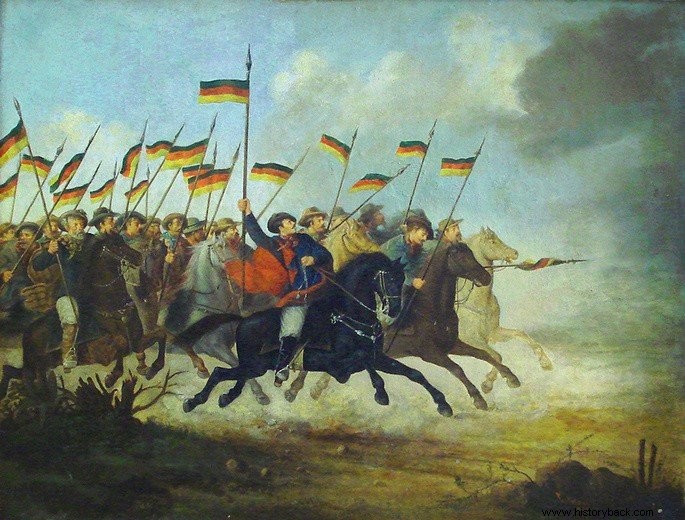The War of the Rags or Farroupilha Revolution it was the longest rebellion of the regency period in Brazil.
It took place in Rio Grande do Sul and lasted ten years, from 1835 to 1845, a period that includes the regency of Feijó and the Second Reign. The term “ragged” referred to the ragged clothing the rebel army wore.
The revolt was mobilized by the great landowners of Rio Grande do Sul, dissatisfied with the high taxes levied by the imperial government on their products. Therefore, they realized that the separation and the republic would be a way to obtain commercial and political freedom.
The enslaved blacks were also recruited to fight, under the promise of freedom, in case of victory in the war against the empire.
The Farroupilha Revolution ends with the Treaty of Poncho Verde, on March 1, 1845.
Causes of the War of the Rags
The Farrapos War was promoted by the Gaucho ruling class. Made up of ranchers who owned large rural properties, cattle and enslaved blacks. Outraged by the high land taxes, in addition to high taxes on beef jerky, leather and tallow exports.
Estancia owners protested that beef jerky from Rio Grande do Sul had to pay 25% tax while Uruguayan beef only paid 4% to be sold in Rio de Janeiro.
There was also resentment against the imperial government, which always recruited men and horses to fight the border territories, but did little to benefit local society.
The revolution was favored by the militarized character of Rio Grande do Sul society, organized in the midst of struggles such as the dispute over Colonia do Sacramento, in the 18th century.
In addition, republican and federative ideas found receptivity among the people of Rio Grande do Sul, encouraged by the neighboring Platine republics.
Aggravating the situation, in 1835, the regent Feijó appointed the moderate Antônio Rodrigues Fernandes Braga as president of the province, which was not accepted by the gauchos. In the Provincial Assembly, opposition to President Fernandes Braga became increasingly alive.
The Farroupilhas Conflicts
On September 20, 1835, an armed revolt, with just over 200 knights, was established on the outskirts of the capital, Porto Alegre. A small armed force sent to disperse the rebels was repulsed and forced to return.
Fernandes Braga fled to the village of Rio Grande, installing his government there. The following day, the commander of the local National Guard, Bento Gonçalves, one of the leaders of the movement, entered Porto Alegre and, with the support of the Provincial Assembly, in 1836, proclaimed the Republic of Piratini.

Faced with this situation, Regent Feijó appointed a new president for the province, José de Araújo Ribeiro, the future Viscount of Rio Grande. The war continued and the loyalists managed to arrest several rebel leaders, among them Bento Gonçalves, who was sent to Forte do Mar (BA), from where he fled swimming.
In September 1837, Bento Gonçalves returned to the South and was elected president of the Republic of Piratini. The rebels' struggle was increasingly popular and with the support of the Italian revolutionary Giuseppe Garibaldi the movement spread.
Meanwhile, due to political disputes, Feijó was forced to resign. The regency of Araújo Lima began, supported by the Conservatives.
In 1839, David Canabarro, one of the leaders of the revolt, with the collaboration of Giuseppe Garibaldi, took Laguna (SC). There, he would meet his future wife and fighting companion, Anita Garibaldi.
The Juliana Republic was founded in this province, confederated to the Rio Grande do Sul Republic, expanding the scenario of the revolution.
In 1840, with Dom Pedro II's early age of majority, amnesty was granted to all political rebels of the regency period.
Then, the new president of Rio Grande do Sul, Álvaro Machado, appointed by the imperial government, tried to convince the rebels to end the war and accept an amnesty, but nothing came of it.
The Porongos Massacre and the end of the conflict
In 1842, to end the conflict, Luís Alves de Lima e Silva, the future Duque de Caxias, was appointed president of Rio Grande do Sul and commander of arms. The objective was to end the fighting and pacify the province.
Faced with the defeats, the Farroupilhas negotiated the end of the conflict with the imperial government. However, the issue of enslaved blacks who had fought for ten years still needed to be resolved.
The imperial government did not accept their release and, on the other hand, some Farroupilha leaders agreed to return them to their former owners. However, that would be a betrayal and could end in a rebellion.
Therefore, on November 14, 1844, the farroupilha camp – led by Canabarro – was attacked by imperial troops. However, where the black spearmen were, it received most of the attack and got no help from its own comrades-in-arms.
In 1845, the rebels accepted the peace proposal offered by the government. The Poncho Verde Treaty established:
- amnesty;
- incorporation of farroupilha officers into the imperial army;
- liberation of slaves who had fought alongside the Farroupilhas;
- return of land that had been taken from the rebels;
- decrease in taxes in that province and
- strengthening of the Provincial Assembly.
The War of the Rags represented a military victory for the Empire's troops, but a political victory on the side of the Rags.
We have more texts on the subject for you :
- Regency Period
- Cabanage
- Sabinada
- Balayada
